Indoor geranium - photos, types, care, propagation, benefits of flowers
Geranium is a flower that in our time has come to be considered “grandmother’s” because it has been known for a very long time in indoor and garden floriculture, and it is mainly the older generation who are engaged in breeding and collecting these plants.
Young people imagine geranium in its standard form: round panicles of red flowers and double dark green leaves. In fact, progress does not stand still, and breeders have discovered many varieties of pelargonium, which differ in flower shape, leaf color, plant size and other parameters.
If you want to purchase a houseplant that will not require constant careful care and annual replanting, while remaining very decorative for a long time, then you should think about growing some variety of indoor geranium.
In order to understand the choice of variety, it is necessary to consider the groups into which indoor pelargoniums are divided. They will be presented below with descriptions of the general characteristics of the species group.
Geranium zonal (bordered)

It can be immediately recognized by the characteristic color of the leaves: the dark green leaf is bordered by a brown stripe, hence the second name of the species. It is the zonal geranium that is the “grandmother’s” species, because this group is the most widespread and has more than 70,000 varieties.
They are separated not only by the color of the flowers, but also by their shape. There are simple, semi-double and double flowers. It is clear that depending on the complexity of the flower, they have a different number of petals.
The leaves also differ in the severity of the dark stripe: in some varieties of geranium it is visible very clearly, in others it is practically invisible, the width of the border also depends on the variety.
Geranium ivy-leaved

This is an ampelous type of pelargonium that produces many long, flowing shoots. In this regard, ivy-leaved geraniums are planted in hanging flowerpots or pots that stand at a height. It should be taken into account that ivy-leaved varieties produce lashes up to 1 m long.
The group is also characterized by the absolute smoothness and glossiness of the leaves, which resemble ivy leaves. Hence the name of the group.
Geranium Angel
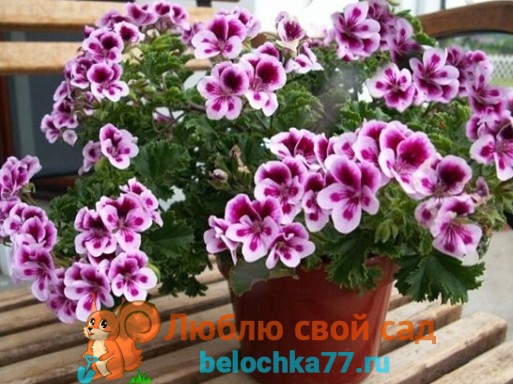
Also applies to hanging ones, however, the lashes are shorter. The flower here is interesting: it very much resembles a viola (pansy) and looks very beautiful in a panicle.
Geranium fragrant
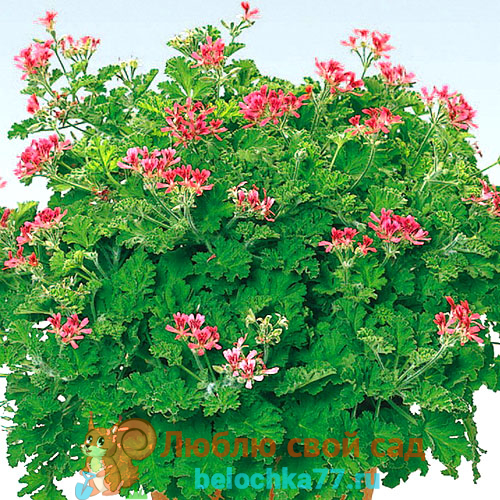
Here, already from the name, it becomes clear why this group is interesting to flower growers. There are a lot of smells, it all depends on the specific variety. The pelargoniums collected in this group contain phytoncides in their leaves, which are responsible for the production of aroma. The smell is very strong, especially when you touch the plant.
I would immediately like to note that the appearance of fragrant geranium is not as interesting as in previous cases: the leaves are green with fluff, uneven and large, the flowers are simple, standard colors.
The plant itself develops quickly and therefore can stretch out at the top. In order for the bush to be a bush and not a couple of long shoots, it is necessary to pinch it periodically.
Royal geranium
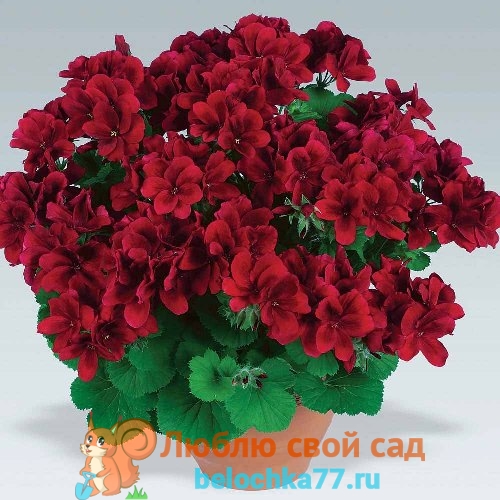
Perhaps the most beautiful pelargoniums belong to this species. The flowers are also collected in paniculate round inflorescences, but each of them can reach 7 cm in diameter. Thus, the flower caps turn out to be simply gigantic. And their color can be very different, and here we mean not only the main color, but also the presence of veins, edges, spots, etc.
Geranium Unicum
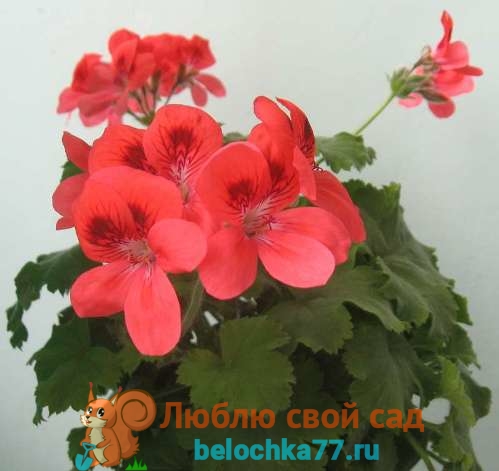
It can truly be considered unique, since it has collected many interesting features: the flowers are very beautiful, with veins and patterns, which the previous group can boast of, but the size, of course, is not so large.
The leaves are also decorative and at the same time have a certain aroma, depending on the specific variety. It is a little weaker than that of fragrant pelargonium, but quite distinct.

They are small bushes that bloom profusely and do not require pruning at all. Varieties of such geraniums will be useful to those whose window sills are already filled with other plants.
Now you can consider some interesting types of geraniums, differing precisely in the shape of the flower. These include:
- Rosaceae zonal. The flowers resemble real small roses collected in a panicle;
- cacti-shaped zonal. It's hard to say whether they are beautiful or not. This is an option for everyone. The flowers themselves are large, and the petals are curled into cones and resemble cactus spines;
- star zonal. They are named so in connection with the shape of the petal - it is pointed, narrowed towards the upper part;
- Dianthus. Carnations have jagged petals, and it is this property that this group of geraniums adopted.
Planting geraniums
Geranium can be purchased in three forms: seeds, rooted cuttings and a well-developed adult bush. Their cultivation must be considered separately.
Pelargonium seeds are quite large, so, as a rule, even novice gardeners do not have problems with planting them. When planting seeds, they are placed with their flat side on the ground, slightly pressing down. The distance between seeds is maintained at least 2 cm.
After they have been planted in the ground, the ground is not watered with a watering can, but sprayed well with a spray bottle, so the seeds will not be washed away and will remain in their places.
Usually, in order for geraniums to have color in the summer, planting their seeds begins at the end of February. A plastic bag is placed over the container in which the seeds are planted. Everything must be put in a dark, warm place and checked daily for germination. Basically, pelargoniums sprout in 5-6 days.

After at least one sprout appears, the entire container is exposed to light and the bag is removed. When the seedlings grow up and have four leaves, they can be planted in separate pots (this operation is called picking).
Growing rooted cuttings and well-developed bush
Here everything will be based on the selection of pot and soil for replanting the purchased seedling. You can buy ready-made soil in a specialized store, or you can make it yourself if you have soil at home brought from the garden in the fall. To do this you just need to mix:
- upper light peat,
- land,
- sand,
- vermiculite
The soil composed in this way will be loose. The selection of a pot is made depending on the condition of the root system of the seedling.
Even for an adult bush, a small pot with a diameter of about 15 cm is suitable. Of course, it is recommended to purchase a pot made of baked clay, but they are usually more expensive than plastic ones.
Therefore, if you don’t want to spend extra money, then the plastic one is not so bad either, it’s just that the water in it does not dry out so quickly, and there is a risk of “flooding” the plant.
It is imperative, in order to prevent root rot and blackleg, that the pot must have high-quality drainage, poured in a layer of 2-3 cm. What can we say, the pot itself must have at least one drain hole at the bottom.

geranium cuttings in peat tablets
Pelargonium care
As was said at the very beginning of the article, geranium is very undemanding in care, which is why gardeners love it. Care represents the fulfillment of the following conditions:
Watering
It all depends on the speed at which the top layer of soil dries out. Geranium tolerates drought much better than excessive humidity, so it is important not to “flood” it, otherwise the bush will die.
Typically watering is carried out about three times a week. By the way, it must be done carefully, trying not to get on the leaves of the plant itself. Spraying geraniums is also undesirable.
Landing location
Geranium is very photophilous, so its flowering directly depends on the amount of sunlight it receives. South-facing, well-lit windows are suitable for growing pelargonium.
Room temperature
This factor is not particularly important in the summer. In winter, the temperature should not fall below 10 0 C. The main thing is to protect the plant from drafts.
Loosening
It is recommended to carry out this operation periodically so that air flows to the roots and the earth does not turn into one monolithic piece. In order to loosen the soil, it is not at all necessary to have a special rake: you can use an old fork or stick.

Top dressing
Geraniums are fed during flowering and before flowering with phosphorus-containing fertilizers. Under no circumstances should you apply organic fertilizers; geraniums simply cannot tolerate them.
Bush formation
It involves rejuvenating pruning of an adult plant and the formation of young plants. In the first case, up to five buds are left on each shoot, from which new branches will appear in the future.
In the second case, the technique of pinching the tops with fingers is used for better tillering. All these operations are recommended to be carried out at the end of winter - beginning of spring.
Transfer
It is carried out not annually, but once every 2-3 years. It is best to replant with a clod of earth without exposing the roots.
Typically, this operation is performed when indoor pelargonium noticeably slows down its development. But this does not mean that the new pot has to be huge. You can increase its diameter by the thickness of your index finger.
Propagation of indoor geraniums
To preserve the characteristic characteristics of the geranium variety, it is usually propagated by cuttings or dividing an adult bush.
Seeds
If you collect the seeds yourself, there is no guarantee that the variety will be preserved. If you want to try planting the collected seeds, then you need to carry out scarification, i.e. removal of the outer shell. The seeds are ground between two pieces of sandpaper.
Cuttings
Still, flower growers most often take cuttings from the bush. Cut cuttings about 6 cm long are placed in water until young white roots sprout and then planted in the ground or germinated in coarse wet sand. Both methods are effective and widely used.

Bloom
Geraniums bloom after planting seeds in about five months, so if they are planted at the end of February, pelargonium will bloom in the same year.
The cuttings will bloom earlier - in three months. However, these terms apply mainly to zonal species; Angels and Royal Pelargoniums will, in any case, bloom only in the second year.
Diseases and pests of pelargonium
The most common diseases of geraniums indoors include fungal and viral diseases. Fungal diseases include blackleg, leaf rust, and various types of rot. Most often, these diseases are treated with fungicide solutions.
There are few pests of geraniums, but they are already very annoying. These include aphids, whiteflies, caterpillars and mites. They themselves or traces of their vital activity can be detected by careful examination of the leaves of the plant on both sides.
You can get rid of pests by spraying geraniums with special products. If it is not possible to determine who exactly settled on the flower, then it is better to use a drug against a complex of pests.

Why do the leaves turn yellow?
Inexperienced gardeners can often encounter the following problems when growing geraniums: the leaves turn yellow, fall off, and the bush itself does not want to bloom at all.
This is most likely the result of improper care.
- If the leaf turns yellow along the edge, it means the bush is getting little water.
- If the leaves are limp and fallen, then the bush is flooded.
- If the leaves fall from the bottom of the plant, then the geranium is not getting enough sunlight. By the way, for the same reason it may not bloom.
- Also, geranium will not want to produce flower stalks if it is overfed with nitrogen, which serves to gain green mass for the plant.
In order not to end with such an unpleasant moment as problems in growing pelargonium, we can talk about its beneficial properties.
Useful properties of geranium
- Firstly, this plant perfectly purifies the indoor air from harmful microbes. The smell of geranium relieves stress and relieves depression.
- Secondly, it repels pests from other flowers and plants. In summer, it is recommended to take geraniums out into the garden, under currant bushes - so that there are no aphids!
- And thirdly, geranium is widely used in folk medicine to treat various diseases. She is compared to a plantain! Fresh leaves perfectly heal wounds and treat ulcers. The decoction helps with intestinal and stomach diseases.
- An essential oil with a delicate aroma is also obtained from geranium, which is used for medicinal purposes. It treats runny nose, ear pain, relieves muscle fatigue, and back pain.
Video about growing pelargonium - geranium
This is such a useful and beautiful plant - pelargonium or indoor geranium. Grow on windowsills, and now you know how to care for them.




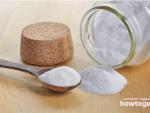



 Nail care
Nail care Prom hairstyle for long hair
Prom hairstyle for long hair 18 wonderful New Year cards that even a child can make
18 wonderful New Year cards that even a child can make The best set of exercises for morning exercises
The best set of exercises for morning exercises